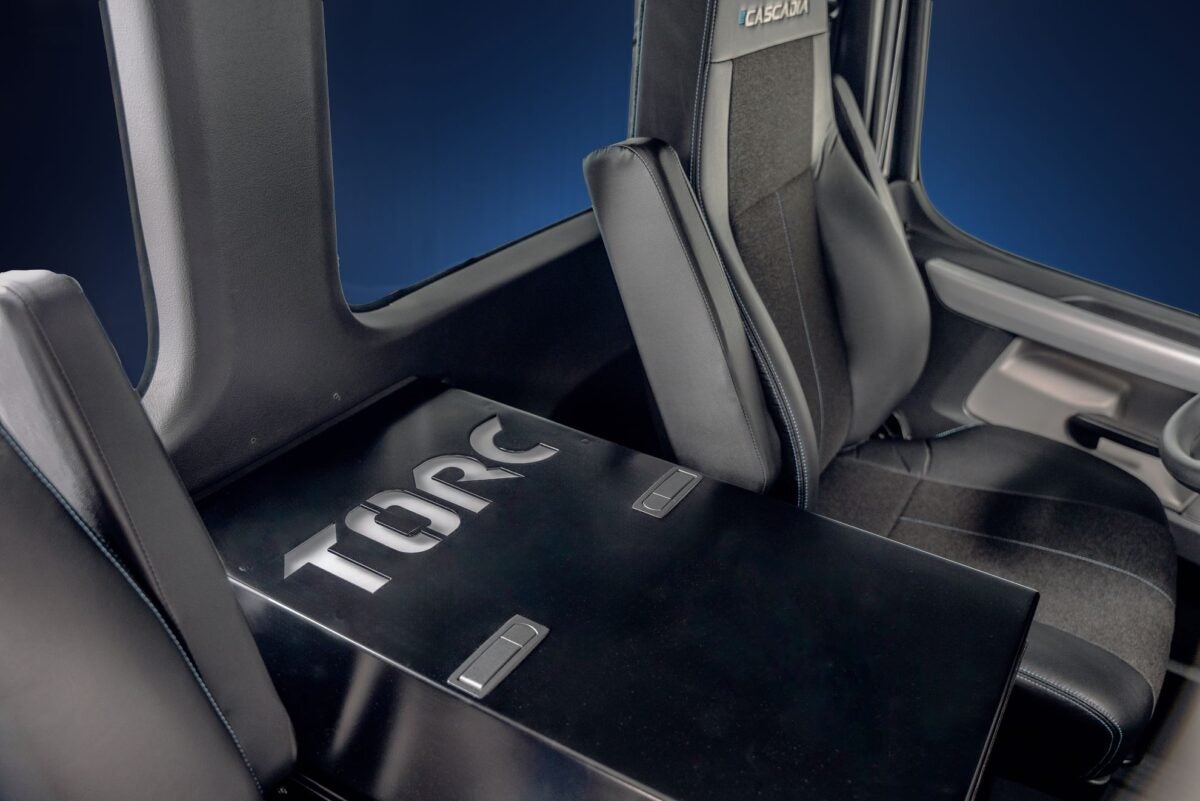"We asked ourselves, ‘What would it look like if we combined the freight efficiency potential of an autonomous truck with the promise of zero emissions and decarbonization of our series production electric vehicle?'" Joanna Buttler, head of the Daimler Truck Global Autonomous Technology Group, said during a virtual news conference.
The German automaker revealed the result Wednesday: an eCascadia with a Level 4 autonomous system from its Torc Robotics subsidiary.

Daimler Truck revealed a Class 8 eCascadia electric truck daycab fitted with Torc Robotics autonomous driving system. (Photo: Daimler Truck North America)
Daimler plans to initially use the demo unit to learn how motion control in an electric truck differs from a diesel-powered engine with an automated manual transmission and whether autonomy impacts the driving range of an electric truck.
A competitor for Gatik?
Daimler hinted at additional applications, such as its Class 6 eM2 electric truck. That could create competition with Gatik, the lone player in middle-mile autonomy.
"We're looking into use cases that could be good for this technology" Buttler said. "We're looking into repeatable and fixed routes and are in process of analyzing where this type of vehicle would be a good match [that would] provide our customers a choice of solution."
Daimler calculations show that short- and medium-haul applications account for 60 billion miles and 11 billion tons of freight are moved annually in short and medium regional haul applications.
Design challenge
The demonstration truck showed Torc's latest upper sensor bar containing long-range lidars, cameras and radars for perception — seeing far ahead on the road as well as capturing nearby traffic and objects that might impede travel.
The demo unit placed the Torc compute unit between the driver and passenger seats — as well as under the passenger seat. The tight quarters presented a design challenge. Autonomous trucks typically use the sleeper cab space behind the driver for the units that compute trillions of bits of data per second.

Engineers packaged the Torc Robotics autonomous compute system between the driver and passenger seats of the Freightliner eCascadia daycab. (Photo: Daimler Truck North America)
An air cooling system and four 12-volt batteries assure the compute unit has sufficient operating power. Safety engineers required both seats remain in the truck so a safety driver and engineer could be on board to monitor the truck's performance.
Torc is testing diesel-powered Cascadias with redundant brakes, steering and power for two major Daimler freight customers — C.R. England and Schneider — along a 960-mile route from Phoenix to Oklahoma City. Each load moved has a safety driver and an engineer on board.
Torc system still targeted for 2027 commercialization
Daimler is sticking to its plans for commercial launch of the Torc driving system in 2027. Two startup competitors, Aurora Innovation AUR and Kodiak Robotics, plan limited commercialization of driverless trucks in Texas this year. Aurora expects to be installing its Aurora Driver system on assembly lines around 2027, allowing scaling to thousands of autonomous trucks.
"We are already able to see how this works by bringing the autonomous system to our production line" Buttler said.
If battery-electric trucks become common, it will be critical for charging infrastructure to be located at launching and landing terminals where driverless trucks bring their loads. Charging at the same time a trailer is swapped or loaded cuts down on dwell time.
Fuel-agnostic autonomous options also in the works
Battery-electric propulsion is just part of Daimler's fuel-agnostic strategy for autonomous trucks. The company plans to offer only zero-emissions trucks in its major markets by 2039.
Hydrogen fuel for an internal combustion engine (ICE) and hydrogen-powered fuel cells are down-the-road options the company is researching. Interest in H2 ICE is growing because governments around the world have expressed willingness to classify them as zero emissions despite minimal nitrogen oxide emissions from burning hydrogen as fuel.
The post Daimler Truck marries electric and autonomous technologies appeared first on FreightWaves.
© 2025 Benzinga.com. Benzinga does not provide investment advice. All rights reserved.
Trade confidently with insights and alerts from analyst ratings, free reports and breaking news that affects the stocks you care about.